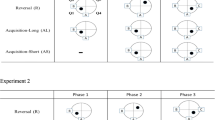Abstract
We have shown previously that phenytoin impairs learning in rats in several different behavioral paradigms (Churchill et al., 1998, 2003; Banks et al., 1999). The present study has examined this drug’s effects on performance in a delayed match-to-place water maze paradigm developed by Steele and Morris (1999). We find that phenytoin retards performance, but only when the inter-trial interval (ITI) is short (i.e., 15-sec). With longer ITIs (i.e., 20-min, 2-hr), the performance of the phenytoin-treated rats was quite comparable to the controls. We suggest that this pattern of results stems from a disruption of spatial working memory, perhaps due to the effects of the drug on hippocampal function (cf., Churchill et al., 1998, 2003). This disruption is, however, not so profound that consolidation is prevented.
Similar content being viewed by others
References
Baddeley, A. (1981). The concept of working memory: A view of its current state and probable future development.Cognition, 10(Suppl. 3), 17–23.
Banks, M.K., Mohr, N.L., Besheer, J., Steinmetz, J.E., & Garraghty, P.E. (1999). The effects of phenytoin in instrumental appetitive-to-aversive transfer in rats.Pharmacology Biochemistry and Behavior, 63, 465–472.
Bear, M.F., Connors, B.W., & Paradiso, M.A. (2001). Memory Systems. In S. Katz, A. Heubeck, & B. Dilernia (Eds.),Neuroscience: Exploring the Brain, 2nd edition (pp. 739–773). Baltimore: Lippincott Williams & Wilkins.
Berger, T.W. & Orr, W.B. (1983). Hippocampectomy selectively disrupts discrimination reversal conditioning of the rabbit nictitating membrane response.Behavioral Brain Research, 8, 49–68.
Churchill, J.D., Voss, S.E., Miller, D.P., Steinmetz, J.E., & Garraghty, P.E. (1998). Phenytoin blocks the reversal of a classically conditioned discriminative eyeblink response in rabbits.Epilepsia, 39, 584–589.
Churchill, J.D., Green, J.T., Voss, S.E., Manley, E., Steinmetz, J.E., & Garraghty, P.E. (2001). Discrimination reversal conditioning of an eyeblink response is impaired, by NMDA receptor blockade.Integrative Physiological and Behavioral Science, 36, 62–75.
Churchill, J.D., Fang, P.-C., Voss, S.E., Besheer, J., Herron, A.L., & Garraghty, P.E. (2003). Some antiepileptic compounds impair learning by rats in a Morris watermaze.Integrative Physiological Behavior Science, 38, 91–103.
Eichenbaum, H. & Cohen, N.J. (2001)From Conditioning to Conscious Recollection: Memory Systems of the Brain. New York: Oxford University Press.
Larsen, J.R. & Larsen, L.S. (1989). Clinical features and management of poisoning due to phenytoin.Medical Toxicology and Adverse Drug Experiences, 4, 229–245.
Morris, R.G.M., Garrud, P., Rawlins, J.N.P., & O’Keefe, J. (1982). Place navigation impaired in rats with hippocampal lesions.Nature, 297, 681–683.
Morris, R.G.M. (1984). Development of water-maze procedures for studying spatial learning in the rat.Journal of Neuroscience Methods, 11, 47–60.
Morris, R.G.M., Andersen, E., Lynch, G., & Baudry, M. (1986). Selective impairment of learning and blockade of long-term potentiation by an N-metyl-D-asparate receptor antagonists.Nature, 319, 774–776.
Olton, D.S. (1979). Maze, maps, and memory.American Psychology, 34, 583–596.
Seif, G.I., Clements, K.M., & Wainwright, P.E. (2004). Effects of distraction and stress on delayed matching-to-place performance in aged rats.Physiology & Behavior, 82, 477–487.
Steele, R.J. & Morris, R.G.M. (1999). Delay-dependant impairment of a matching-to-place task with chronic and intrahippocampal infusion of the NMDA-antagonist D-AP5.Hippocampus, 9, 118–136.
Schwartzkroin, P.A., Moshe, S.L., Noebels, J.L., & Swann, J.W. (1995).Brain Development and Epilepsy, New York: Oxford University Press.
Author information
Authors and Affiliations
Corresponding author
Rights and permissions
About this article
Cite this article
Samuelson, D.L., Arnold, L.L., Mowery, T.M. et al. The effects of phenytoin on the performance of rats in a delayed match-to-place task. Integr. psych. behav. 40, 17–27 (2005). https://doi.org/10.1007/BF02734185
Issue Date:
DOI: https://doi.org/10.1007/BF02734185




